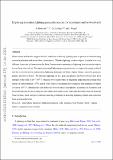Files in this item
Exploring terrestrial lightning parameterisations for exoplanets and brown dwarfs
Item metadata
| dc.contributor.author | Hodosán, G. | |
| dc.contributor.author | Helling, Ch. | |
| dc.contributor.author | Vorgul, I. | |
| dc.date.accessioned | 2022-05-27T23:42:37Z | |
| dc.date.available | 2022-05-27T23:42:37Z | |
| dc.date.issued | 2021-09-15 | |
| dc.identifier | 274636138 | |
| dc.identifier | 2087c613-344b-4e16-9105-44f492948a9f | |
| dc.identifier | 000671580300004 | |
| dc.identifier | 85107630590 | |
| dc.identifier.citation | Hodosán , G , Helling , C & Vorgul , I 2021 , ' Exploring terrestrial lightning parameterisations for exoplanets and brown dwarfs ' , Planetary and Space Science , vol. 204 , 105247 . https://doi.org/10.1016/j.pss.2021.105247 | en |
| dc.identifier.issn | 0032-0633 | |
| dc.identifier.other | RIS: urn:0D97681EB2FE1AC0BDCD58E6AD55B283 | |
| dc.identifier.uri | https://hdl.handle.net/10023/25458 | |
| dc.description | We highlight financial support of the European Community under the FP7 by an ERC starting grant number 257431. Ch. H. acknowledges funding from the European Union H2020-MSCA-ITN-2019 under Grant Agreement no. 860470 (CHAMELEON). | en |
| dc.description.abstract | Observations and models suggest that the conditions to develop lightning may be present in cloud-forming extrasolar planetary and brown dwarf atmospheres. Whether lightning on these objects is similar to or very different from what is known from the Solar System awaits answering as lightning from extrasolar objects has not been detected yet. We explore terrestrial lightning parameterisations to compare the energy radiated and the total radio power emitted from lightning discharges for Earth, Jupiter, Saturn, extrasolar giant gas planets and brown dwarfs. We find that lightning on hot, giant gas planets and brown dwarfs may have energies of the order of 1011–1017 J, which is two to eight orders of magnitude larger than the average total energy of Earth lightning (109 J), and up to five orders of magnitude more energetic than lightning on Jupiter or Saturn (1012 J), affirming the stark difference between these atmospheres. Lightning on exoplanets and brown dwarfs may be more energetic and release more radio power than what has been observed from the Solar System. Such energies would increase the probability of detecting lightning-related radio emission from an extrasolar body. | |
| dc.format.extent | 19 | |
| dc.format.extent | 9167877 | |
| dc.language.iso | eng | |
| dc.relation.ispartof | Planetary and Space Science | en |
| dc.subject | Atmospheric electricity | en |
| dc.subject | Lightning discharge | en |
| dc.subject | Radio emission | en |
| dc.subject | Solar system | en |
| dc.subject | Earth − Jupiter − Saturn | en |
| dc.subject | Exoplanets | en |
| dc.subject | Brown dwarfs | en |
| dc.subject | QB Astronomy | en |
| dc.subject | QC Physics | en |
| dc.subject | T-NDAS | en |
| dc.subject.lcc | QB | en |
| dc.subject.lcc | QC | en |
| dc.title | Exploring terrestrial lightning parameterisations for exoplanets and brown dwarfs | en |
| dc.type | Journal article | en |
| dc.contributor.sponsor | European Research Council | en |
| dc.contributor.sponsor | European Commission | en |
| dc.contributor.institution | University of St Andrews. School of Physics and Astronomy | en |
| dc.contributor.institution | University of St Andrews. St Andrews Centre for Exoplanet Science | en |
| dc.identifier.doi | https://doi.org/10.1016/j.pss.2021.105247 | |
| dc.description.status | Peer reviewed | en |
| dc.date.embargoedUntil | 2022-05-28 | |
| dc.identifier.url | https://arxiv.org/abs/2103.10155 | en |
| dc.identifier.grantnumber | 257431 257431 | en |
| dc.identifier.grantnumber | 860470 | en |
This item appears in the following Collection(s)
Items in the St Andrews Research Repository are protected by copyright, with all rights reserved, unless otherwise indicated.

